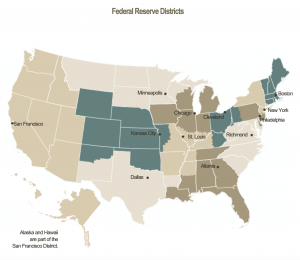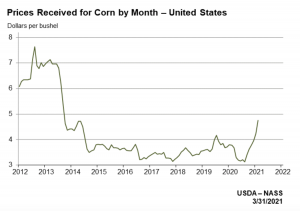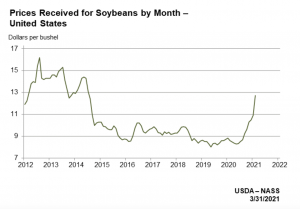Beef prices are projected to continue increasing as U.S. beef production declines with no signs of a cattle herd rebuild. Additionally, cheap beef may soon become further out of reach…
Federal Reserve: Observations on the Ag Economy- April 2021
On Wednesday, the Federal Reserve Board released its April 2021 Beige Book update, a summary of commentary on current economic conditions by Federal Reserve District. The report included several observations pertaining to the U.S. agricultural economy.

* Sixth District- Atlanta– “Agricultural conditions remained mixed. Abnormally dry conditions persisted in some areas. On a month-over- month basis, the March production forecast for Florida’s orange crop was down while the grapefruit production forecast was unchanged; both forecasts were below last year’s production. The USDA reported year-over-year prices paid to farmers in February were up for corn, cotton, soybeans, broilers, and eggs but down for cattle and milk; rice was unchanged. On a month-over-month basis, prices increased for corn, cotton, rice, soybeans, cattle, broilers, and eggs, but decreased for milk.”


* Seventh District- Chicago–
Prospects for agriculture income in 2021 improved as many agricultural prices rose and more federal support was announced.
“Corn and soybean prices moved higher during the reporting period, while wheat prices lagged. Dry conditions in much of the District set the stage for a fast planting season, with some types of planting already having begun. Cattle, egg, hog, and dairy prices increased during late February and March. While higher feed costs hurt livestock producers, the outlook for profits was still good. Farm equipment sales continued to be strong, and farmland values again rose.”
By April 11, producers had planted 4 percent of the nation’s #corn crop, 1 percentage point ahead of both last year and the 5-year average. #Texas was the furthest advanced in planting progress, with 57 percent planted. https://t.co/j0f6lDcSpH pic.twitter.com/wYlBmb6SAz
— Farm Policy (@FarmPolicy) April 13, 2021
* Eighth District- St. Louis– “District agricultural conditions differed little from the previous reporting period. Row crop acres planted was relatively unchanged compared with the same period in 2020, although planting was up moderately in Kentucky, Tennessee, and Mississippi. Corn and rice were planted in lesser quantities compared to last year, while cotton and soybean acreage increased.
A national agricultural lender contact indicated an optimistic outlook for the industry.
“They noted they are returning to operating at pre-pandemic levels and expect strong growth in 2021.”
"A few participants noted that higher #crop prices were continuing to boost income in the #agricultural sector."
— Farm Policy (@FarmPolicy) April 7, 2021
-- Minutes of the Federal Open Market Committee March 16–17, 2021, https://t.co/gjyA1OcYeJ @federalreserve pic.twitter.com/KkNHsDOY8Z
* Ninth District- Minneapolis– “Agricultural conditions improved briskly heading into spring planting, as prices for many commodities continued to increase well above their recent levels.”
* Tenth District- Kansas City– “Agricultural economic conditions in the Tenth District remained favorable, but prospects in the cattle industry were slightly weaker than for other major commodities. Contacts continued to report that strong crop prices were supporting a profitable outlook for most producers. However, the price of fertilizers used in crop production increased rapidly in March, and while many farmers likely had already purchased inputs for the 2021 growing season, a sustained increase in expenses could reduce profit margins going forward. In the livestock sector, hog prices increased sharply in March, while cattle prices remained stable and below pre-pandemic levels. In addition to weak price conditions, drought and higher feeding costs, cattle producers in the southern portion of the District also were adversely impacted by recent winter weather events.”
* Eleventh District- Dallas– “Drought conditions eased somewhat in parts of the District but intensified in others. Row crop planting was underway with low soil moisture a concern.
Crop prices remained largely profitable and some pushed higher over the reporting period, spurring optimism among producers.
“While the winter wheat crop did not suffer much damage from Winter Storm Uri, damage to other areas of Texas agriculture (citrus, livestock, and vegetables) is estimated to exceed $600 million.”
* Twelfth District- San Francisco– “Conditions in the agriculture and resources sectors remained stable overall. Inclement weather negatively affected some crop yields, but sales of wheat, corn, raisins, nuts, fruit, and soybeans were generally steady. Inventories moved down but from relatively high levels earlier in the year. Growers reported seeing some tapering in demand from abroad on account of an appreciating dollar. Others noted ongoing negative effects of international supply chain disruptions, which were exacerbated by the temporary closure of the Suez Canal. Contacts also mentioned continued concerns about COVID-related labor shortages. In California, producers highlighted low water availability as a risk to production.”





